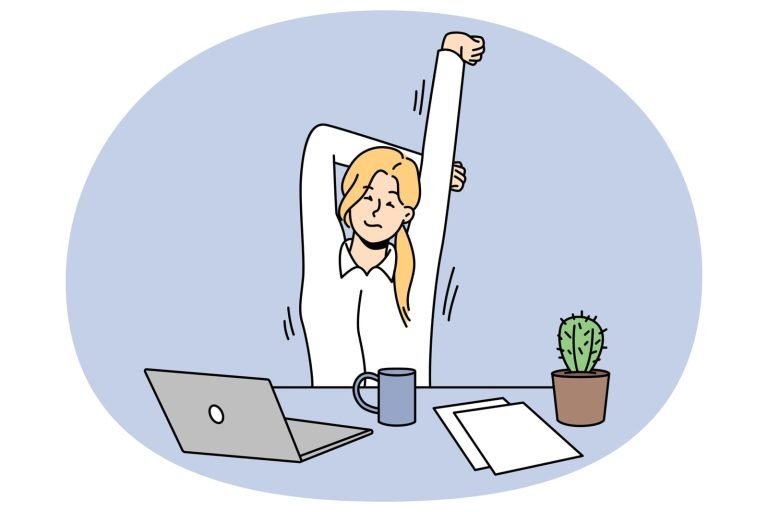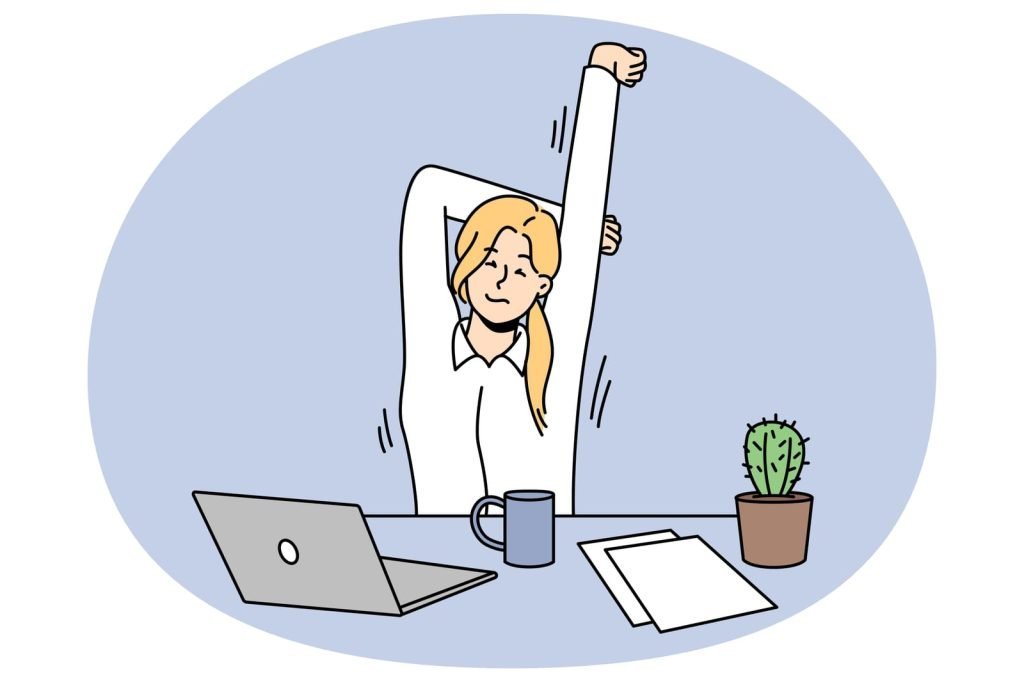
In this blog post, Laurens Holve provides tips on how to avoid back pain while sitting at a desk. He emphasizes the importance of taking regular breaks and being more active during these breaks. Lawrence also demonstrates a few simple exercises that can be done within a couple of minutes to invigorate the back and reduce pain.
Regular Breaks After Sitting At Your Computer Too Long
Regular breaks are essential for maintaining productivity and focus throughout the day. Whether you are working, studying, or pursuing any other activity that requires mental or physical exertion, taking breaks at regular intervals is crucial for your well-being and overall performance.Take a break every 30-40 minutes
Research suggests that our brains can only maintain a high level of focus for a limited period. After about 30-40 minutes of continuous activity, our concentration starts to decline. To combat this, it is recommended to take a short break every 30-40 minutes. During these breaks, try to distance yourself from your work. Step away from your desk, stretch your legs, and do something unrelated to your current task. By doing so, you give your mind a chance to recharge and prepare for the next session.Use this time to be more active
Instead of simply sitting or scrolling through social media during your breaks, try to be more active. Engaging in physical activity, even for a few minutes, can have numerous benefits for both your physical and mental health. You can take a short walk, do some stretching exercises, or even engage in quick bursts of aerobic activity. These activities help improve blood circulation, increase oxygen supply to the brain, and release endorphins, which in turn boost your mood and energy levels.Avoid sitting for long periods without a break
In today’s sedentary world, many of us spend a significant amount of time sitting, whether it’s at a desk, in front of a screen, or during long commutes. Prolonged sitting can have detrimental effects on our health, including increased risk of obesity, heart disease, and even certain types of cancer. To counteract the negative effects of sitting, it is crucial to incorporate regular breaks into your day. Sitting for long periods without a break can strain your back, neck, and shoulders, leading to musculoskeletal issues. Taking short breaks to stand up, stretch, and move around can help alleviate these problems and improve your overall comfort. During your breaks, you can also try using standing desks or adjustable workstations that allow you to alternate between sitting and standing positions. This can further reduce the negative impact of prolonged sitting on your health.Incorporating regular breaks into your routine
Now that you understand the importance of regular breaks, it’s essential to find ways to incorporate them into your daily routine. Here are a few tips:- Set a timer or use a productivity app that reminds you to take breaks at regular intervals.
- Plan your breaks in advance and decide how you want to spend them. This will help you make the most of your break time.
- Use your breaks to engage in activities that you enjoy and help you relax. This can include reading a book, listening to music, or practicing deep breathing exercises.
- Encourage your colleagues or study buddies to take breaks together. This can help create a supportive environment and make it easier to stick to your break schedule.
Quick Exercises
When it comes to staying fit and active, finding quick and effective exercises can make all the difference. Sometimes, our busy schedules may not allow for long workout sessions, but that doesn’t mean we can’t still get our bodies moving and energize ourselves. In this blog post, we will explore three quick exercises that can be done anytime, anywhere to help you stay active and feel great.Lift Your Legs Up or Run on the Spot
One of the easiest and most effective quick exercises you can do is lifting your legs up or running on the spot. This exercise helps to increase your heart rate, improve blood circulation, and engage multiple muscle groups in your lower body. To perform this exercise, simply stand upright with your feet shoulder-width apart. Then, lift one leg up as high as you can while keeping the knee straight. Hold the position for a moment before lowering your leg back down. Repeat this movement with the opposite leg. You can do it for 20 seconds or choose to run on the spot for the same duration. This exercise is great for warming up your body and getting your heart pumping.Move Your Arms Vigorously
Our arms play a significant role in many daily activities, and moving them vigorously can help increase blood flow and engage the muscles in your upper body. This quick exercise can be done anywhere, making it a convenient choice for those short on time. To start, stand up straight with your feet shoulder-width apart. Extend your arms out in front of you and then start moving them vigorously, as if you are slapping your hands together in front of your body. Continue this movement for 20 seconds, making sure to keep your arms engaged and your wrists loose. Not only will this exercise get your blood flowing, but it can also help to improve your overall upper body strength.Stretch Exercise: Move Your Legs Back and Forth
Stretching is an essential part of any exercise routine, as it helps to improve flexibility and prevent muscle tightness. This stretch exercise focuses on your legs and can be done in just 15-20 seconds. To start, stand upright with your feet hip-width apart. Then, lift one leg up and move it forward as far as you can comfortably reach. Hold the position for a few seconds before bringing the leg back to the starting position. Repeat this movement with the opposite leg, moving it backward. Continue alternating between legs for 15-20 seconds. This exercise helps to stretch your leg muscles and increase mobility in your hips and thighs. Quick exercises are an excellent way to stay active and fit, even when you have a busy schedule. The three exercises mentioned above — lifting your legs up or running on the spot, moving your arms vigorously, and stretching your legs back and forth — can be done in just a few minutes and provide numerous benefits. Whether you’re looking to increase your heart rate, engage your muscles, or improve flexibility, these quick exercises are sure to help you achieve your fitness goals. So, next time you find yourself short on time, remember that a quick workout is better than no workout at all!Bridges Exercise
Bridges exercise is an effective and versatile workout routine that targets the back muscles and helps improve overall strength and flexibility. This exercise involves lifting your back up and either moving up and down or swaying back and forth. It is a simple yet powerful movement that can be incorporated into your fitness routine to invigorate and push blood to the back, as well as decompress the back area.Lift Your Back Up
The foundational movement of bridges exercise is lifting your back up off the ground. This can be done by lying flat on your back with your knees bent and your feet hip-width apart. Place your arms by your sides, palms facing down. Engage your core muscles and press your feet into the ground as you lift your hips off the floor. Keep your weight evenly distributed across your feet and shoulders as you lift. Aim to create a straight line from your knees to your shoulders. You can use your glutes, hamstrings, and lower back muscles to support this movement. Hold the position for a few seconds, focusing on maintaining good form and engaging the right muscles. Then slowly lower your back down to the starting position. Repeat the movement for the desired number of repetitions.Move Up and Down or Sway Back and Forth
Once you have mastered the basic movement of lifting your back up, you can add variations to make the exercise more challenging and engaging. One option is to move up and down, lifting your back up as high as comfortable and then lowering it back down in a controlled manner. Another option is to sway back and forth, shifting your weight from your heels to your toes as you lift your back up and lower it back down. This variation adds a dynamic element to the exercise and further engages your core and lower body muscles.Benefits of Bridges Exercise
The bridges exercise offers several benefits for your back and overall fitness:- Improved Back Strength: By regularly performing bridges exercise, you can strengthen the muscles in your back, including the glutes, hamstrings, and lower back. This increased strength can help alleviate back pain and improve posture.
- Enhanced Flexibility: Bridges exercise also helps improve the flexibility of your back muscles. The movement of lifting your back up and down or swaying back and forth stretches the muscles, promoting better range of motion.
- Increased Blood Flow: The upward movement in bridges exercise helps invigorate and push blood to the back area, improving circulation. This can provide nourishment and oxygen to the back muscles, aiding in their overall health and function.
- Decompression of the Back: Bridges exercise can also help decompress the back area, especially the lower back. By lifting your back up, you create space between the vertebrae, reducing pressure and promoting spinal health.
- Core Activation: When performing bridges exercise, you engage your core muscles to stabilize your body. This activation of the core muscles helps improve core strength and stability.





